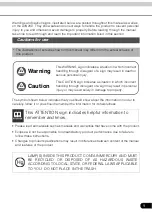
8
Chapter 1
The Basics
Manufacturer/Vendor Card Compatibility
Please go to
www.RFIDeas.com
for specific device part numbers associated to card types.
Reader Configuration Purposes
The method of encoding data on a card and transmitting data to the reader differs accordingly to
each technology involved. The reader itself is not aware of the makeup of the card data format or
access privileges for the cardholder. This information is only accessible through the configuration
process of the reader utilizing the supplied software.
The reader is very flexible and may need to be configured in order to present an exact desired output
for the user, such as, singling out FAC or ID, obtaining a desired base (i.e. decimal, lowercase, upper-
case, hexadecimal).
Differences Between pcProx Plus Reader Non-Plus Reader
The pcProx Plus is a dual frequency programmable reader that combines 125 kHz and 13.56 MHz
technologies into the same reader. It’s the only reader in the industry that reads two cards of your
choice among 35 card types, delivering flexibility to any customer struggling with different card
technologies.
In contrast to the pcProx Plus reader, our standard pcProx Enroll proximity and contactless readers
function on a single frequency band, which is either 125 kHz proximity or 13.56 MHz contactless.
Summary of Contents for pcProx Plus
Page 1: ...99009010 Rev U pcProx Plus pcProx Enroll Wiegand Converter Configuration Utility User Manual...
Page 6: ...ID Card Reader System Output Formats 6 Chapter 1 The Basics...
Page 10: ...10 Chapter 2 Hardware Interface Connectors OUTPUT CONNECTORS T...
Page 34: ...34 Chapter 3 Software GetQueuedID Data Display HH MM SS displays 00 00 06...









































